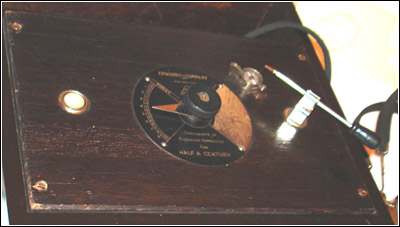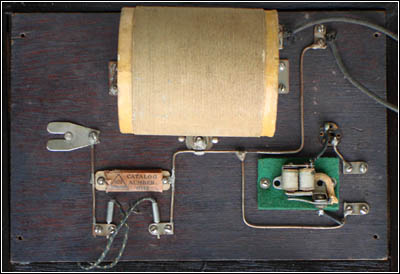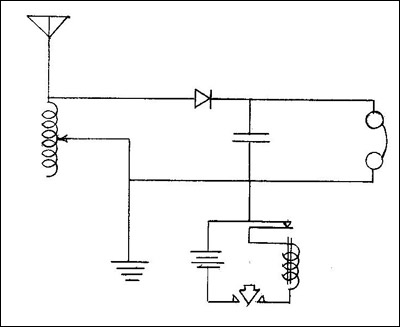Of Old Radios And Related Items--Published Monthly
The Edwards Signaling Company Crystal Set
BY BOB MURRAY
Web Edition
In the following article, Bob Murray tells us about a piece of crystal radio history. His Edwards crystal set is now a museum piece, but there may be other Edwards sets out there that we can add to this bit of history. (Editor)
Edwards and Company, now a subsidiary of General Electric Security, was founded in 1872 by Robert Edwards and David Rousseau to explore the new phenomenon of electricity and to manufacture battery-operated gas fixture igniters. Among the company's first customers was a New York City church where sextons had climbed a 100-foot ladder to light gas fixtures located high above the pews. In 1873, Rousseau withdrew from the company and was replaced by Adam Lungen. Edwards and Lungen invented an electric doorbell and a burglar alarm.
In 1881, Robert Edwards obtained his first patent for an electric bell. In 1882, he patented a drop-type annunciator. In 1883, he patented an electric gas burner lighter for push-button operation, and in 1884, an electric door opener.
In 1884, Edwards displayed its wares at the first electrical show in the United States. Held in Philadelphia, it was called the "Electrical Exhibit, National Conference of Electricians."
Figure 2. The top of the panel contains a dial plate etched in silver and naming the company as "Specialists in Signaling Apparatus for half a century."In 1886, the Edwards catalog listed for the first time electrically wound clocks, program systems, and coils. In 1896, Edwards stopped installing electrical devices and limited its activities to the design and manufacture of signaling, communications and protection equipment. In 1903, Edwards installed the New York Stock Exchange bell to signal the start and end of trading each day.
Edwards Crystal Sets
The year 1922 marked the 50th anniversary of the Edwards Company. In recognition of the anniversary, the Company built a number of crystal sets. These sets seem to have been used as corporate gifts in areas where the company was seeking to install industrial signals and alarms.
An example of an Edwards crystal set, found in Winnepeg, Manitoba, Canada, is shown in Figure 1 (see print version). A dial plate etched in silver, shown in Figure 2, identifies "Edwards and Company Inc., New York City," as "Specialists in Signaling Apparatus for HALF A CENTURY."
The company apparently did not make a large number of these sets, since they escaped the attention of crystal set expert Maurice Sievers in his Crystal Clear books and the early receiver historian Morgan McMahon in Vintage Radio.
The Restoration Process
The panel of the set as found was in good condition. Missing were the detector arm, the crystal, and the cabinet. These have been fabricated.
The detector arm was made from 1/8" brass rod and plated with nickel. Its knob was turned from a scrap of mahogany and finished with black enamel.
Figure 3. The back of the panel showing crystal set components, the coil at top, and the buzzer lower right. Lower left, the metal label is marked with the company triangular logo stating "1872 Edwards" and the catalog number 0117.The panel appeared to be made from mahogany and stained with mahogany. The case was made from 7/16" mahogany and finished with Minwax mahogany stain followed by Minwax Jacobean stain. The case was then lacquered with three coats of Deft brush-on, semi-gloss lacquer. The cabinet catches are from discarded 35mm slide storage cases. The handle is from a Canadian military surplus instrument case.
Figure 3 shows the back of the panel with the company triangular logo on a metal label also containing the catalog number 0117 and "1872 Edwards."
The circuit, shown in Figure 4, is rudimentary. It would have been a poor performer in an area like New York City where discrimination of adjacent stations would have been an issue. It may have performed somewhat better in Winnipeg.
The set consists of a tuning coil with a single slider, operated by a knob on the panel. The tuning dial is calibrated from 0 to 9, and there is an area to the right of the tuning knob where the operator could write in pencil the names and settings for stations received. See Figure 2 again.
There is also a buzzer to help with setting the cat's whisker. This feature does not generally appear in books for home builders in 1922, but it was more common in earlier years. Bucher describes it in 1917 in his Wireless Telegraphy.
While it is not really essential on this crystal set, the Edwards Company made buzzers! They also made the phone condenser on the underside of the panel. According to the Edwards historian in a response to a website query, there is no record of Edwards having made a radio receiver.
Figure 4. A schematic of the rudimentary circuit. The tuning coil with slider is on the left; the phones are on the right; the crystal is at the upper middle; and the buzzer circuit is on the lower right. A capacitor, center, couples the buzzer to the crystal detector.The restored Edwards crystal set featured in this article is now in the AWA Museum in Bloomfield, New York. I would be interested to hear from anyone who has found another one.
References:
Bucher, Elmer E. Practical Wireless Telegraphy, Revised Edition. New York, NY: Wireless Press, 1917, page 167.
http://edwardssignals.com/index. cfm?PG=21&level=50&sid=0.
McMahon, Morgan E. Vintage Radio, Third Edition. Palos Verdes Peninsula, CA: Vintage Radio, 1981.
Sievers, Maurice L. Crystal Clear, Vol. 1, Vestal, NY: The Vestal Press Ltd., 1991.
_____ Crystal Clear, Volume 2. Chandler, AZ: Sonoran Publishing LLC, 1995.
Bob Murray has been collecting radios for over 25 years, and has gradually come to emphasize radios made in Canada in the 1920s. He is interested in restoration and research in radio history. Bob is the current editor of the "Antique Wireless Association Review."
|
[Free Sample] [Books, etc., For Sale] [Subscribe to A.R.C./Renew] [Classified Ads] [Auction Prices] [Event Calendar] [Links] [Home] [Issue Archives] [Book Reviews] [Subscription Information] [A.R.C. FAQ]URL = http://www.antiqueradio.com/Nov08_Murray_Crystal.html Copyright © 1996-2008 by John V. Terrey - For personal use only. Last revised: October 30, 2008. For Customer Assistance please contact ARC@antiqueradio.com or call (866) 371-0512 toll free Pages designed/maintained by Wayward Fluffy Publications Antique Radio Classified |


